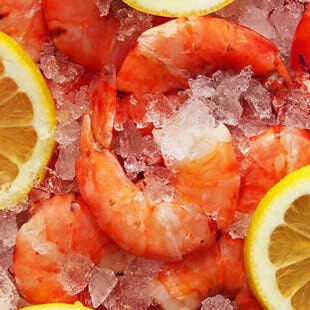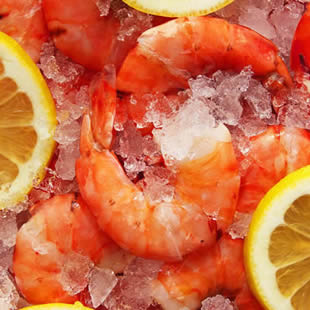

By Matthew Thompson, Associate Food Editor for EatingWell Magazine
It really pays to read the label when it comes to buying seafood, especially shrimp. Taking a few extra seconds in the supermarket aisle to figure out just what exactly is in your food and where it came from can make a huge difference for the environment.
Most shrimp are plentiful and reproduce quickly. But whether they are sustainably farmed or harvested is the big question. Both wild-caught and farm-raised shrimp can damage the surrounding ecosystems when not managed properly. Trawling for wild-caught shrimp can result in by-catch (other species that are caught in fisherman’s nets) and cause damage to ocean floors. Issues with farm-raised shrimp include pollution, disease and escape. The U.S. has strict regulations on farming and trawling so fortunately, it is possible to buy shrimp that have been raised or caught with sound environmental practices. (See Tip 3 below for advice on what to look for to buy the most sustainable shrimp.)
As for shrimp’s health profile, although shrimp is high in dietary cholesterol it has virtually no saturated fat. Nutritionists and scientists agree that unless dietary cholesterol intake is combined with high saturated fat, it does not elevate blood cholesterol. Plus, shrimp is a lean source of protein. The mild flavor of this shellfish makes them a great way to eat toward the new MyPlate dietary guidelines of getting 8 ounces or more of seafood a week.
To avoid confusion at the fish counter, check out these simple tips for picking the right shrimp:
1. Pay Attention to Count. Size names like “jumbo” or “extra large” aren’t standardized, so they don’t mean a whole lot when it comes to shrimp size. Instead, look to the “count” number on the label. Shrimp is usually sold by the number needed to make one pound, so the lower the count, the bigger the shrimp. If you see “21-25 count” on the label, that is a pretty standard size, and is larger than “31-35 count.” To be sure you’re getting the size you want, order by the count (or number) per pound. Choose the count that’s recommended for the dish you’re making and remember they don’t take long to cook so don’t overcook them.
2. Go Frozen. Most “fresh” shrimp sold in supermarkets in the United States have been shipped frozen and then thawed for the fish counter. That means that the shrimp you find in the freezer aisle is exactly the same as what’s presented as “fresh”—it just hasn’t been sitting around on a bed of ice all day. Unless you know beyond the shadow of a doubt that your fish counter shrimp is really, truly fresh from the ocean, the frozen variety is probably a bit fresher. And you can take it home and keep it frozen just until you’re ready to use it so you’re sure it’s as “fresh” as possible. To thaw, put it in the refrigerator, covered, for about a day to defrost or place in a colander under cool running water.
3. Look for Certifications. Look for shrimp certified by an independent agency, such as Wild American Shrimp or the Marine Stewardship Council, which certifies that wild fisheries are well-managed and sustainable. Or look for the Best Aquaculture Practices label, which is for farmed (not wild) shrimp, raised without antibiotics and in conditions that exceed local environmental regulations. Plants that process the fish employ safe-packaging practices to reduce risk of foodborne illnesses. Only farms prohibiting practices that harm natural habitats are eligible for the label. The label is regulated through site inspections and audits implemented by the nonprofit Aquaculture Certification Council to ensure that farms and processing plants meet environmental and safety standards.
If you can’t find a certification, opt for wild-caught shrimp from North America—it’s more likely to be sustainably caught. The best choices are wild-caught MSC-certified pink shrimp from Oregon or their larger sisters, spot prawns, also from the Pacific Northwest or British Columbia, which are caught by traps. Avoid: imported shrimp.
4. Check your Choice: There are two other ways to get information on the purchase you want to make. You can carry a pocket guide, such as the handy wallet-size guides for seafood and sushi that you can download or order from Carl Safina’s Blue Ocean Institute (blueocean.org) and Seafood Watch (seafoodwatch.org). Or you can ask the Fish Phone. Text 30644 with the word “fish” followed by a space and the seafood you are considering. In about 10 seconds you will get up-to-date information from the Blue Ocean Institute, which has facts and sustainability ratings for more than 90 species of seafood.
Must-Read:
What questions do you have about buying seafood?
Matthew Thompson is the associate food editor for EatingWell Magazine.
More from EatingWell: